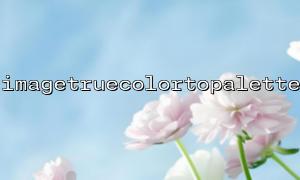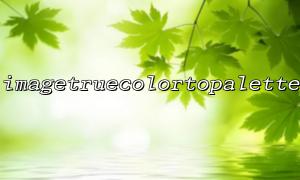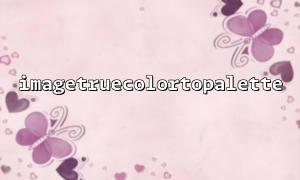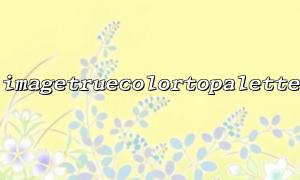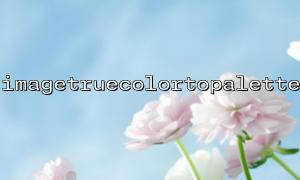Image processing is a common task in PHP, especially when it comes to image compression. When dealing with image files, particularly when handling large numbers of images, optimizing file size can significantly improve loading speed and reduce server load. The imagetruecolortopalette function is a useful tool that can help you convert images from true color mode to palette mode, thereby reducing file size. This article will guide you on how to use the imagetruecolortopalette function and share best practices for effectively compressing image file sizes.
The imagetruecolortopalette function is part of the PHP GD library. It converts a true color image (24-bit color) into a palette-based image (usually 8-bit color). By reducing the color depth, this function can significantly compress the image file size. This is particularly important for applications that require image uploads, generating thumbnails, or displaying images on web pages.
The function prototype is as follows:
bool imagetruecolortopalette ( resource $image, bool $dither, int $num_colors )
Parameter Explanation:
$image: The image resource to be processed (usually created with imagecreatefromjpeg(), imagecreatefrompng(), etc.).
$dither: Whether to enable dithering (a subtle noise effect that can appear when reducing colors, set to true to enable it).
$num_colors: The maximum number of colors in the final image (typically 256 or fewer).
The function’s purpose is to reduce the number of colors in an image to a specified amount and return a compressed version of the image, suitable for display on the web.
Many image formats (such as JPEG and PNG) have large file sizes, especially when the image contains many colors and details. Image file size directly affects page load speed, particularly when browsing on mobile devices; large files may result in slow loading times.
By converting a true color image to a palette-based image, we can reduce the image's color depth, thus effectively compressing its file size. Here are some of the main advantages of using the imagetruecolortopalette function:
Reduced Color Depth: The image color depth is reduced from 24-bit (true color) to 8-bit (palette mode), significantly decreasing the image file size.
Improved Load Speed: Smaller image files can significantly accelerate page loading.
Bandwidth Savings: Smaller files save bandwidth, which is important for applications that require image uploads or downloads.
Here is a simple example of using the imagetruecolortopalette function to compress an image:
<?php
// Load image
$image = imagecreatefromjpeg('input.jpg');
<p>// Convert image to palette mode with up to 256 colors, enable dithering<br>
imagetruecolortopalette($image, true, 256);</p>
<p>// Output image to file<br>
imagepng($image, 'output.png');</p>
<p>// Clean up memory<br>
imagedestroy($image);<br>
?><br>
In the code above, we load a JPEG image using imagecreatefromjpeg(), then use imagetruecolortopalette() to convert the image to a palette mode with a maximum of 256 colors. Finally, we save the compressed image as a PNG file.
Choosing the appropriate number of colors ($num_colors) is crucial for balancing compression and image quality. Here are some suggestions for selecting the number of colors:
256 Colors: Suitable for most standard images, particularly those with fewer colors, such as icons or simple graphics.
128 Colors or Fewer: Suitable for situations where further image compression is needed, such as generating small icons or simplified images. Note that reducing the number of colors can decrease image quality, so adjustments should be made according to the specific needs.
No Dithering vs. Dithering: Dithering makes color transitions appear more natural but increases the file size. If the image has significant color differences, you may want to disable dithering.
Although the imagetruecolortopalette function is highly effective for image compression, there are a few considerations to keep in mind when using it:
Using Dithering: If higher image quality is needed, consider enabling dithering. However, note that enabling dithering will increase the file size. For low-quality or low-resolution images, dithering may not be necessary.
Comparing Before and After Compression: It's a good practice to compare the original image and the compressed version each time you compress an image. For complex images, over-compression may lead to image distortion, negatively affecting the user experience.
Batch Image Processing: If you need to process multiple images, you can wrap the above code in a function and apply it to multiple images. Use functions like glob() to iterate over image files in a folder and compress them in batch.
Choosing the Right Image Format: PNG format is well-suited for palette-based images, but JPEG format is more effective for photos. Therefore, when selecting a compression format, consider the type of image being processed.
The imagetruecolortopalette function is a powerful tool for reducing image file sizes, making images more suitable for web usage. By converting true color images to palette-based images, you can significantly improve page load speed and save bandwidth. When using the function, it’s important to choose the right number of colors and dithering options based on your specific requirements to achieve optimal compression results.
With proper use and configuration, you can significantly optimize image resources on your website, enhancing the user experience and speeding up page load times.
